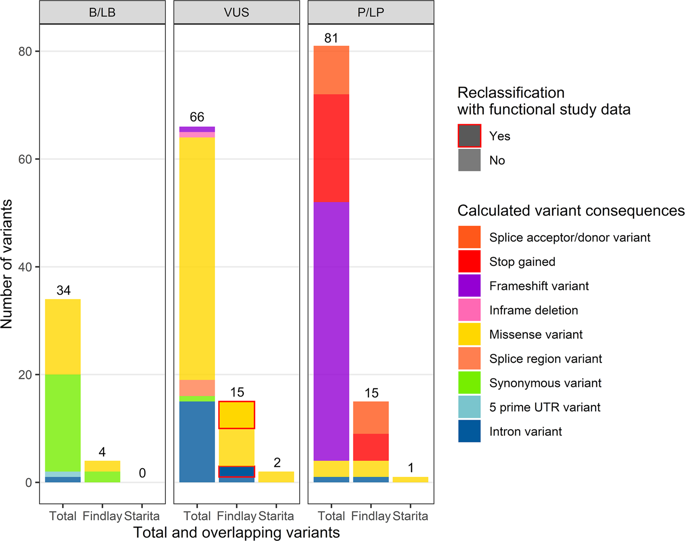当前位置:
X-MOL 学术
›
J. Hum. Genet.
›
论文详情
Our official English website, www.x-mol.net, welcomes your
feedback! (Note: you will need to create a separate account there.)
Impact of proactive high-throughput functional assay data on BRCA1 variant interpretation in 3684 patients with breast or ovarian cancer.
Journal of Human Genetics ( IF 2.6 ) Pub Date : 2020-01-06 , DOI: 10.1038/s10038-019-0713-2 Hyun-Ki Kim 1 , Eun Jin Lee 2 , Young-Jae Lee 3 , Jisun Kim 4 , Yongsub Kim 5 , Kyunggon Kim 5 , Shin-Wha Lee 3 , Suhwan Chang 5 , Young Joo Lee 4 , Jong Won Lee 4 , Woochang Lee 1 , Sail Chun 1 , Byung Ho Son 4 , Kyung Hae Jung 6 , Yong-Man Kim 3 , Won-Ki Min 1 , Sei-Hyun Ahn 4
Journal of Human Genetics ( IF 2.6 ) Pub Date : 2020-01-06 , DOI: 10.1038/s10038-019-0713-2 Hyun-Ki Kim 1 , Eun Jin Lee 2 , Young-Jae Lee 3 , Jisun Kim 4 , Yongsub Kim 5 , Kyunggon Kim 5 , Shin-Wha Lee 3 , Suhwan Chang 5 , Young Joo Lee 4 , Jong Won Lee 4 , Woochang Lee 1 , Sail Chun 1 , Byung Ho Son 4 , Kyung Hae Jung 6 , Yong-Man Kim 3 , Won-Ki Min 1 , Sei-Hyun Ahn 4
Affiliation

|
The clinical utility of BRCA1/2 genotyping was recently extended from the selection of subjects at high risk for hereditary breast and ovary cancer to the identification of candidates for poly (ADP-ribose) polymerase (PARP) inhibitor treatment. This underscores the importance of accurate interpretation of BRCA1/2 genetic variants and of reducing the number of variants of uncertain significance (VUSs). Two recent studies by Findlay et al. and Starita et al. introduced high-throughput functional assays, and proactively analyzed variants in specific regions regardless of whether they had been previously observed. We retrospectively reviewed all BRCA1 and BRCA2 germline genetic test reports from patients with breast or ovarian cancer examined at Asan Medical Center (Seoul, Korea) between September 2011 and December 2018. Variants were assigned pathogenic or benign strong evidence codes according to the functional classification and were reclassified according to the ACMG/AMP 2015 guidelines. Among 3684 patients with available BRCA1 and BRCA2 germline genetic test reports, 429 unique variants (181 from BRCA1) were identified. Of 34 BRCA1 variants intersecting with the data reported by Findlay et al., three missense single-nucleotide variants from four patients (0.11%, 4/3684) were reclassified from VUSs to likely pathogenic variants. Four variants scored as functional were reclassified into benign or likely benign variants. Three variants that overlapped with the data reported by Starita et al. could not be reclassified. In conclusion, proactive high-throughput functional study data are useful for the reclassification of clinically observed VUSs. Integrating additional evidence, including functional assay results, may help reduce the number of VUSs.
中文翻译:

主动高通量功能测定数据对 3684 名乳腺癌或卵巢癌患者的 BRCA1 变异解释的影响。
BRCA1/2 基因分型的临床应用最近从选择患有遗传性乳腺癌和卵巢癌的高风险受试者扩展到识别聚(ADP-核糖)聚合酶(PARP)抑制剂治疗的候选者。这强调了准确解释 BRCA1/2 遗传变异和减少具有不确定意义的变异 (VUS) 数量的重要性。Findlay 等人最近的两项研究。和 Starita 等人。引入了高通量功能分析,并主动分析特定区域的变体,无论之前是否观察到它们。我们回顾性审查了 2011 年 9 月至 2018 年 12 月期间在峨山医疗中心(韩国首尔)检查的所有乳腺癌或卵巢癌患者的 BRCA1 和 BRCA2 种系基因检测报告。根据功能分类为变异分配了致病或良性的强证据代码,并根据 ACMG/AMP 2015 指南重新分类。在具有可用 BRCA1 和 BRCA2 种系基因检测报告的 3684 名患者中,鉴定了 429 个独特的变异(181 个来自 BRCA1)。在与 Findlay 等人报道的数据相交的 34 个 BRCA1 变体中,来自 4 名患者(0.11%,4/3684)的三个错义单核苷酸变体从 VUS 重新分类为可能的致病性变体。四个被评分为功能性的变体被重新分类为良性或可能的良性变体。与 Starita 等人 报告的数据重叠的三个变体。无法重新分类。总之,主动高通量功能研究数据对于临床观察到的 VUS 的重新分类很有用。
更新日期:2020-01-06
中文翻译:

主动高通量功能测定数据对 3684 名乳腺癌或卵巢癌患者的 BRCA1 变异解释的影响。
BRCA1/2 基因分型的临床应用最近从选择患有遗传性乳腺癌和卵巢癌的高风险受试者扩展到识别聚(ADP-核糖)聚合酶(PARP)抑制剂治疗的候选者。这强调了准确解释 BRCA1/2 遗传变异和减少具有不确定意义的变异 (VUS) 数量的重要性。Findlay 等人最近的两项研究。和 Starita 等人。引入了高通量功能分析,并主动分析特定区域的变体,无论之前是否观察到它们。我们回顾性审查了 2011 年 9 月至 2018 年 12 月期间在峨山医疗中心(韩国首尔)检查的所有乳腺癌或卵巢癌患者的 BRCA1 和 BRCA2 种系基因检测报告。根据功能分类为变异分配了致病或良性的强证据代码,并根据 ACMG/AMP 2015 指南重新分类。在具有可用 BRCA1 和 BRCA2 种系基因检测报告的 3684 名患者中,鉴定了 429 个独特的变异(181 个来自 BRCA1)。在与 Findlay 等人报道的数据相交的 34 个 BRCA1 变体中,来自 4 名患者(0.11%,4/3684)的三个错义单核苷酸变体从 VUS 重新分类为可能的致病性变体。四个被评分为功能性的变体被重新分类为良性或可能的良性变体。与 Starita 等人 报告的数据重叠的三个变体。无法重新分类。总之,主动高通量功能研究数据对于临床观察到的 VUS 的重新分类很有用。











































 京公网安备 11010802027423号
京公网安备 11010802027423号